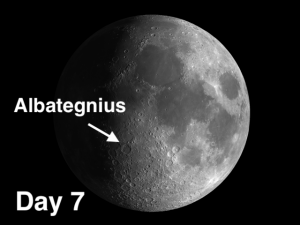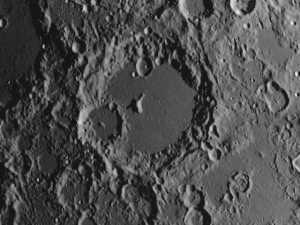 Merry Christmas everyone! The week of December 25-31 takes us from Day 7 to Day 13, very nearly full moon. This week we will highlight the crater Albategnius, viewable on Monday night (just in case you don’t know what to do with yourself on Christmas Eve).
Merry Christmas everyone! The week of December 25-31 takes us from Day 7 to Day 13, very nearly full moon. This week we will highlight the crater Albategnius, viewable on Monday night (just in case you don’t know what to do with yourself on Christmas Eve).
 Albategnius: [SE/L10] Albategnius is a delight! It is an 85-mile complex crater located just east of the Ptolemaeus trio in the central Highlands (the trio should be just touching the terminator Monday night). Sunrise over Albategnius is a lovely sight, as the jagged peaks on the eastern rim will cast many shadow spires on the floor. This is a good place to observe the standard sequence of crater formation. Look for hints that alert you to the comparative ages of the different craters. On its southwest rim, Albategnius is overlapped by Klein (27 mi.) which in turn is intruded upon by Klein A (± 5 mi.) on its NE rim. Both Albategnius and Klein have central peaks, but notice how Albat’s central mountain seems to have been pushed off center and, astonishingly, a meteorite has landed with precise accuracy on the very tip of its highest peak, leaving a tiny craterlet as a memento! Because the craterlet is only 1 mile in diameter, it will seriously test your optics, the seeing conditions, and your experience!
Albategnius: [SE/L10] Albategnius is a delight! It is an 85-mile complex crater located just east of the Ptolemaeus trio in the central Highlands (the trio should be just touching the terminator Monday night). Sunrise over Albategnius is a lovely sight, as the jagged peaks on the eastern rim will cast many shadow spires on the floor. This is a good place to observe the standard sequence of crater formation. Look for hints that alert you to the comparative ages of the different craters. On its southwest rim, Albategnius is overlapped by Klein (27 mi.) which in turn is intruded upon by Klein A (± 5 mi.) on its NE rim. Both Albategnius and Klein have central peaks, but notice how Albat’s central mountain seems to have been pushed off center and, astonishingly, a meteorite has landed with precise accuracy on the very tip of its highest peak, leaving a tiny craterlet as a memento! Because the craterlet is only 1 mile in diameter, it will seriously test your optics, the seeing conditions, and your experience!
Before reading the below footnote, look closely at Albategnius and see if you can spot any evidence that will tell you whether it was in place before or after Mare Crisium was formed.1
OF ADDITIONAL INTEREST IN SPACE FROM DECEMBER 25-31:
If you live in the eastern U.S., you can watch the Moon occult Aldebaran around 6:30 PM (6:24 for New York).
1 Immediately NE of Albategnius, touching its rim, you can see evidence of Imbrium sculpting–long grooves pointing directly back, with accusing fingers, towards Mare Imbrium, verifying that Albategnius was in place before the impact that excavated Mare Imbrium.
======================
It is highly recommended that you get a copy of Sky and Telescope’s Field Map of the Moon, the very finest Moon map available for use at the telescope. It is available for $10.95 at www.skyandtelescope.com and on Amazon. All features mentioned in this blog will be keyed to the grid on the Field Map and will look like this: Plato: [NW/D9]
Credits:
Courtesy of Gray Photography of Corpus Christi, Texas
Lunar photos: NASA / USGS / BMDO / LROC / ASU / DLR / LOLA / Moon Globe. Used by permission
- Rupes Cauchy: A Best Known Fault on the Moon - July 22, 2024
- Moon Crater Schickard – Crater Floor has Stripes - July 15, 2024
- Moon Craters Langrenus and Vandelinus - July 8, 2024